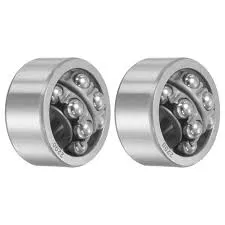
Nov . 06, 2024 14:35 Back to list
Exploring the Features and Applications of 22211 Bearing in Various Industries
Understanding the 22211 Bearing A Vital Component in Mechanical Engineering
Bearings play a crucial role in mechanical systems, reducing friction between moving parts and enabling smooth motion. Among the various types of bearings, the 22211 spherical roller bearing stands out due to its unique design and functional attributes. This article delves into the characteristics, applications, and advantages of the 22211 bearing, underscoring its significance in engineering and industrial applications.
Design and Characteristics
The 22211 bearing is a type of spherical roller bearing that consists of an outer ring, an inner ring, and a set of spherical rollers that are housed between them. This design allows the bearing to accommodate both radial and axial loads, making it versatile for various applications. The key dimensions of the 22211 bearing typically include an inner diameter of 55 mm, an outer diameter of 100 mm, and a width of 25 mm. Its spherical roller configuration enables self-alignment, meaning it can easily compensate for axial misalignments without compromising performance.
One of the defining features of the 22211 bearing is its ability to handle high shock and vibration loads, which makes it suitable for applications where these conditions are prevalent. Additionally, the bearing is often equipped with internal clearance designed to support various operating temperatures, enhancing its reliability and longevity.
Applications
The versatility of the 22211 bearing allows it to be utilized in a wide range of applications across different industries. In heavy machinery, for instance, it is commonly found in conveyor systems, crushers, and milling equipment, where it facilitates smooth and efficient operation under high loads. The automotive industry also employs the 22211 bearing in different components, such as wheel hubs and differentials, where it contributes to vehicle performance and handling.
22211 bearing

Moreover, the 22211 bearing is essential in the mining and construction sectors, where its robust design can withstand harsh conditions and heavy use. In wind turbines, it plays a critical role in enabling the rotor blades to rotate smoothly, which is vital for energy generation. Its ability to manage both radial and axial loads makes it an ideal choice for dynamic applications, ensuring operational efficiency while minimizing downtime.
Advantages
One of the primary advantages of the 22211 bearing is its self-aligning ability. This feature allows it to maintain proper alignment even when subjected to shaft misalignments or housing deflections, which can occur during operation. As a result, the bearing experiences reduced stress and increased lifespan, leading to lower maintenance costs and enhanced reliability.
Furthermore, the spherical roller design of the 22211 bearing allows it to accommodate significant load capacities while maintaining a relatively compact size. This factor is particularly advantageous in modern engineering, where space constraints often dictate design choices. The bearing can also operate efficiently at high speeds and under varying temperature conditions, making it a versatile option for many mechanical systems.
Conclusion
In summary, the 22211 spherical roller bearing is an integral component in modern mechanical engineering, known for its self-aligning capabilities, high load capacity, and durability. Its applications span multiple industries, from heavy machinery and automotive to renewable energy systems like wind turbines. As technology continues to advance, the importance of reliable, efficient bearings like the 22211 will only increase, underscoring the need for high-quality components in maintaining the efficiency and longevity of mechanical systems. By understanding the characteristics and advantages of the 22211 bearing, engineers and industry professionals can make informed decisions that enhance performance and reduce operational costs in their applications.
Latest news
-
Grooved Ball Bearing Design and Functionality
NewsJun.04,2025
-
Concrete Mixer Bearing Load Capacity Testing
NewsJun.04,2025
-
6004 Bearing Dimensions in Robotic Joint Designs
NewsJun.04,2025
-
Advantages of Single-Row Deep Groove Ball Bearings
NewsJun.04,2025
-
Applications of Deep Groove Ball Bearings in Automotive Systems
NewsJun.04,2025
-
Innovations in Bearing Pressing Machine Design
NewsJun.04,2025
